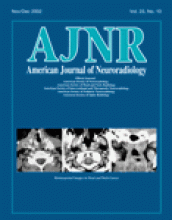Abstract
BACKGROUND AND PURPOSE: Ionic solutes diffuse more slowly in cartilage than do nonionic ones. The purpose of this study was to test the hypothesis that the contrast between scar and recurrent herniated disk fragment on MR images is greater after the IV administration of an ionic rather than a nonionic contrast medium.
METHODS: Patients who had undergone previous laminectomy and who had MR imaging evidence of recurrent herniated disk were enrolled in the study and underwent lumbar MR imaging with the nonionic medium gadodiamide and on a subsequent day with the ionic contrast medium gadopentetate dimeglumine. Enhancement of scar and disk was measured by one of the investigators as the ratio of signal intensity change from baseline to the baseline signal intensity and was plotted as a function of time. Differences in enhancement for scar and disk fragment for the two contrast media were tested for significance by using the Student t test of the means.
RESULTS: Eight patients were enrolled in the study and were studied with the two contrast media within 4 weeks. The average enhancement of the disk fragment at 5 minutes was 0.1 with the ionic medium and 0.4 with the nonionic medium. The difference was significant at P < .05. Contrast between scar tissue and disk tissue was greater with the ionic than with the nonionic medium at both 5 and 20 minutes because of the lower concentration of ionic contrast medium in the disk fragment.
CONCLUSION: With clinical imaging of patients with recurrent herniated disks, disk fragments enhance less after the administration of an ionic rather than a nonionic medium. Contrast between disk fragment and scar tissue is greater after the use of an ionic contrast medium than a nonionic one.
- Copyright © American Society of Neuroradiology












